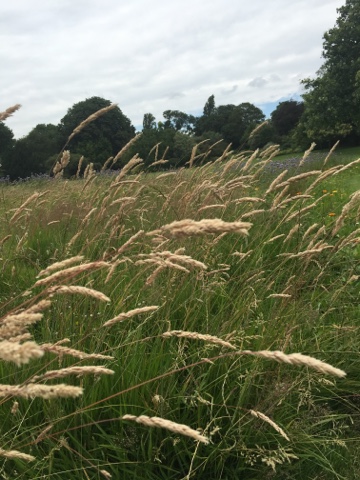Stephen Crisp has been Head Gardener at Winfield House since 1987. As Winfield House is the Official Residence of the Ambassador of the United States of America to the Court of St.James's, he's seen a lot of presidents and prime ministers come and go - and ambassadors too. When he started, Margaret Thatcher was best friends with Ronald Reagan. Since then there have been ten ambassadors and it is Stephen who has been the constant gardener throughout this time, shaping and developing the garden in keeping with its different needs, status, and setting - and the results blew me away.
The entrance to Winfield House is through some modest iron gates on the Inner Circle of Regent's Park. Once through security, I was met by eglantine pink roses at the lodge house, skirting the front of the formal knot-type topiary on the wall and blowing gently in the wind.
The garden is exceedingly big - twelve and a half acres in all and the second largest private garden in London after Buckingham Palace. The garden has to be there for the private needs of the Ambassador's family, visits of official guests, and garden parties and BBQs. All managed by Stephen and two other gardeners. Here they have been rather innovative with what was a traditional pyracantha hedge, pruning it into a cloud hedge.
There are formal parts to the garden where Stephen has tried to move away from using roses - with some success. The heleniums and dahlias he has chosen here, alongside pittosporum hedges, tall grasses and verbena bonariensis worked well. In another part of the garden he replaced some climbing roses with hornbeam to equally good effect.
But roses have not entirely disappeared and still steal the show when they are at their best.
Stephen and his team guard their time and use it to good effect - important if only three of you are managing twelve and a half acres. Central to his gardening philosophy is the tenet of leaving no bare earth, to minimise the need for weeding. Leaves are swept onto beds in the autumn and wood clippings are shredded and used liberally as cover - in addition to compost. He also believes that the work you do in January is as important as that in July.
Winfield House and the whole estate was developed by Barbara Hutton, the Woolworth heiress. Formerly Hertford Villa, and then St Dunstan's Villa, she bought the house in 1936 as a home for her new son, where he would be safe and secure. No expense was spared in the renovation, and for a brief time parties were hosted here on a grand scale. But, with war looming and her marriage failing, she returned to America in 1939. She came back to the house with her new husband, Cary Grant, after the war but the building had fallen into disrepair and she gave it to the American government for a dollar. This statue is of Barbara Hutton.
Near the front of the house roses have also been replaced with hollyhocks, teasels, euphorbia, aquilegia and phormium. They give height to the border and mostly support themselves without any staking. All the annuals in the garden are grown on site - with the help of some very impressive greenhouses, where we were treated to a tasting of some early sungold cherry tomatoes.
This is known as the gold border, on the right of the main house, with a beautiful yellow and green herbaceous border. The garden furniture was repainted dark green and the white plastic pots given a Farrow and Ball make-over. Elsewhere plants in the herbaceous borders include phlomis, yellow tree peonies, Begonia grandis subsp. evansiana, Californian tree poppies and geraniums.
The little gate is a cute touch at the edge of this wild area and brings a smile to visitors' faces. Nearby I saw a fox skipping across the grass. Walking on, the sweep of the land with its natural grass and wild flower planting before Winfield House is superb. You could forget entirely that you were in central London.
Grasses are a strong feature of the garden. As well as delighting in the open meadow areas, many of the 150 new trees that have been planted are surrounded by large wild grass circles, complementing the deciduous Eurasian hardwoods and exotic ornamentals that have been chosen.
Last year Michelle Obama planted a pear tree in the garden, which stands out as one of the few fruit trees you see. As she leaves office as First Lady and a new president appoints another ambassador for London, Stephen Crisp will be here to welcome them into their new garden and to continue to keep it so beautifully well tended.












No comments:
Post a Comment